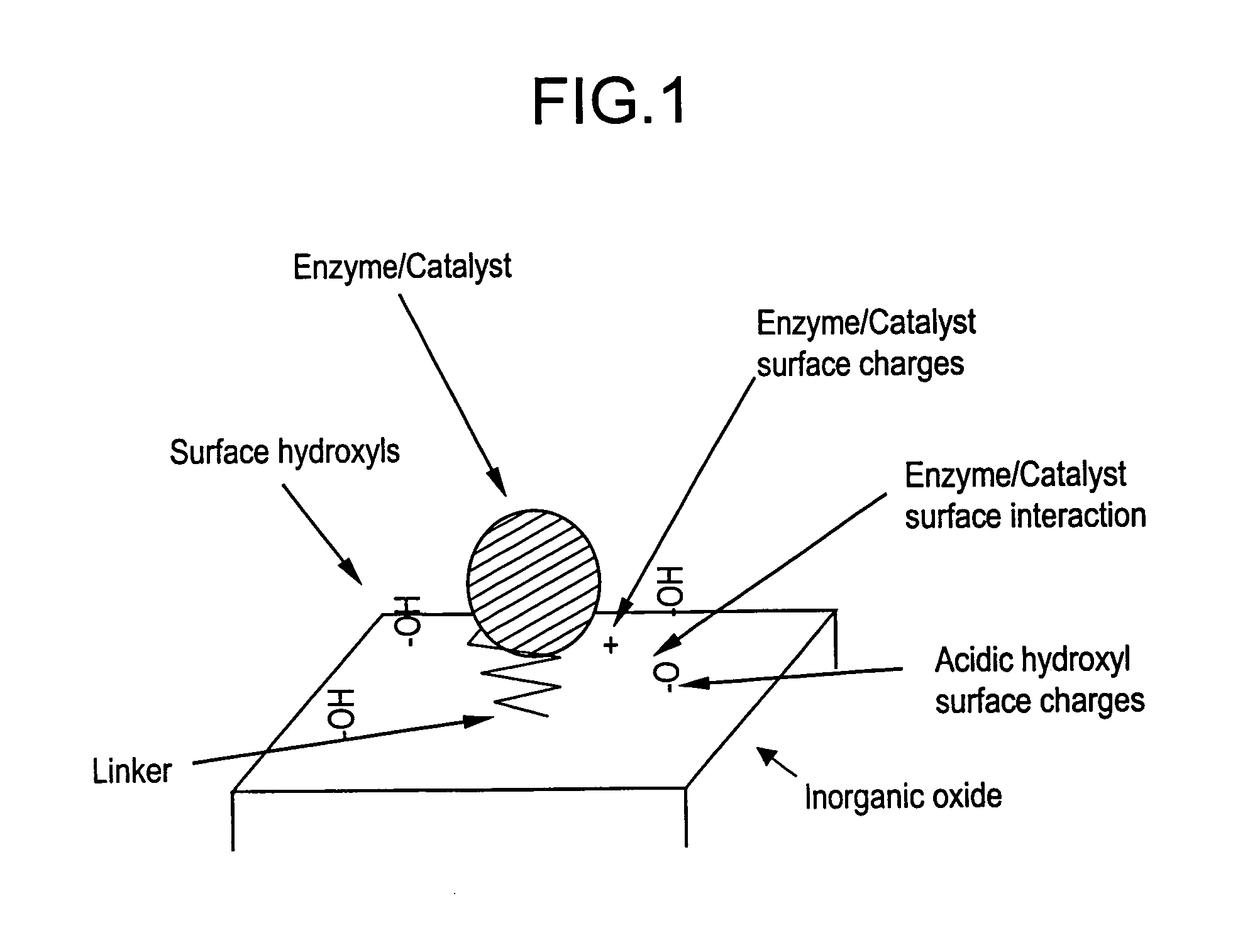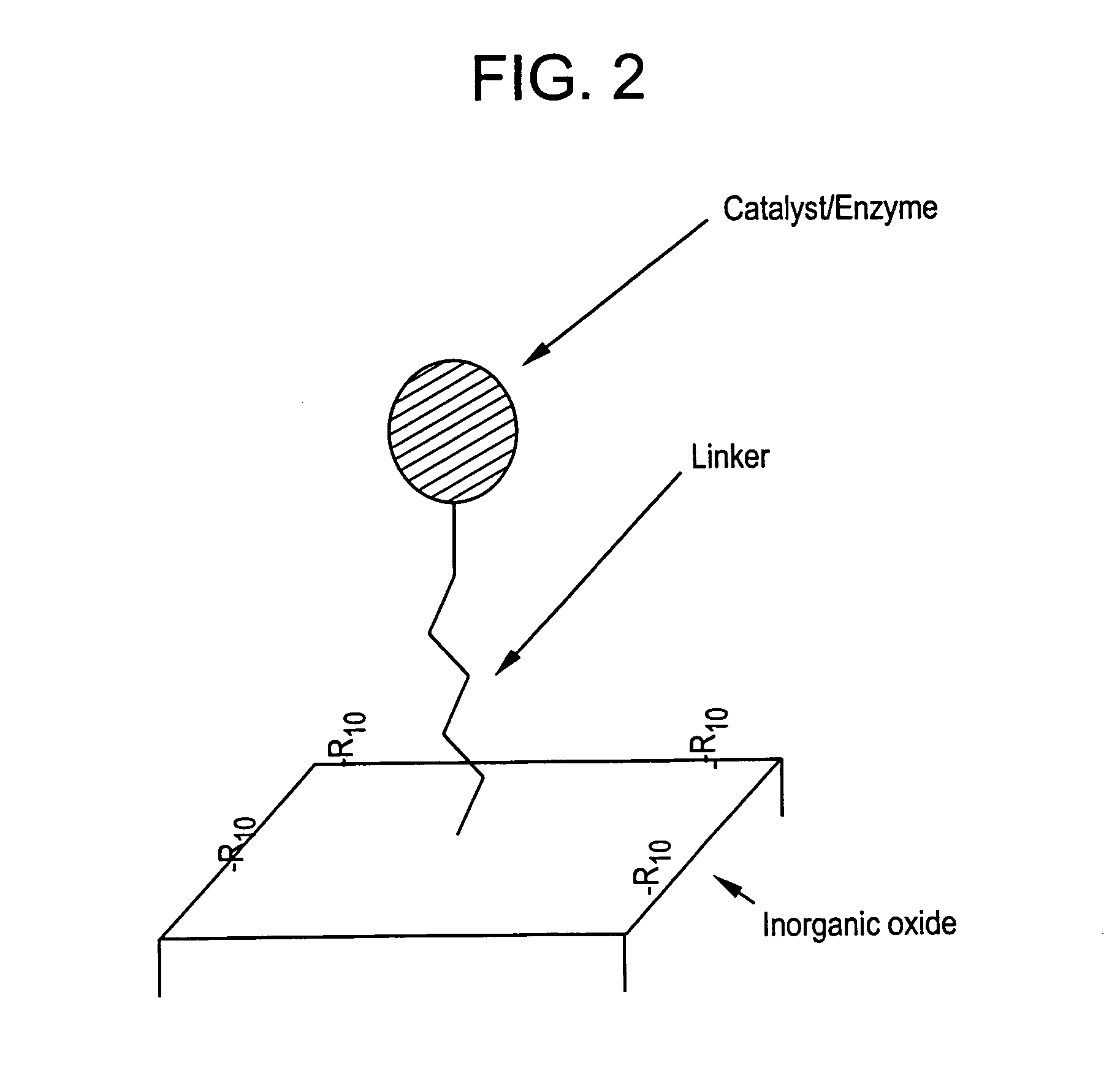Supported catalyst systems
a catalyst system and catalyst technology, applied in the field of supported catalyst systems, can solve the problems of leaving them catalytically inactive, and achieve the effects of reducing the ability to non-specifically, reducing the ability to hydrophobic interactions, and reducing the ability to electrostatic interactions
- Summary
- Abstract
- Description
- Claims
- Application Information
AI Technical Summary
Benefits of technology
Problems solved by technology
Method used
Image
Examples
examples 1 and 2
Non-Specific Binding on Conventional Silica Media
[0127]These examples show that the neat uncoated charged silica surface of the prior art strongly adsorbs proteins based mostly on isoelectric point and the surface area of the silica. Two types of silicas were tested: Examples 1 and 2.
[0128]Example 1 is a low surface area silica gel with a surface area=161 m2 / g after 4 hours at 150° C. heat treat (micropore=73 m2 / g; mesopore=88 m2 / g; pore volume=0.373 cc / g; average pore diameter=93 Å).
[0129]Example 2 is a higher surface area / pore volume silica gel, surface area=253 m2 / g after 4 hours at 150° C. heat treat (micropore=35 m2 / g; mesopore=218 m2 / g; pore volume=2.445 cc / g; average pore diameter=387 Å).
[0130]The examples below describe a procedure wherein the neat silica samples of Examples 1 and 2 were contacted with a complex mixture of proteins in aqueous solution. The resultant supernatant was then analyzed by isoelectric focusing gel electrophoresis for protein adsorption.
[0131]A vial ...
examples 3-5
Non-Selective Binding on Hydrophobic Supports
[0134]These examples show that when silica is coated with hydrophobic groups, or methyl or octyl groups, strong adsorption occurs, especially at moderate ion strength of the solvent (approximately 0.1 M NaCl).
[0135]The support of Example 3 is an uncoated neat commercial wide pore silica from W. R. Grace & Co., XWP-gel P 005, SA=72 m2 / g, with 50 nm pore median that had been activated for 2 hours at 150° C.
[0136]The support of Example 4 is the silica of Example 3 coated with methyl groups as described below.
[0137]The support of Example 5 is the silica of Example 3 coated with octyl groups as described below.
[0138]The support of Example 4 was prepared as follows: in a 250 ml round bottom flask, 50 ml toluene and 6.16 g of methyltriethoxysilane were added. Then 10.1 g of the silica of Example 3 were added to the toluene / methyltriethoxysilane solution. N2 was flowed for 5 minutes to remove air and continued for the entire reaction. The sample ...
examples 6-8
Reducing Non-Selective Binding using an R10 Group
[0147]Examples 6-8 show the advantage of employing an R10 group according to the invention for reducing non-selective protein binding to a silica surface.
[0148]The support of Example 6 is the same as the silica of Example 3 except the silica was activated for 2 hours at 200° C.
[0149]The support of Example 7 is an intermediate surface composition, with the silica surface having Si—R groups attached, wherein R is acetoxymethyl.
[0150]The support of Example 8 is an example of the surface composition of the present invention, with the silica surface having Si—R10 groups attached, wherein R10 is methylhydroxy. The advantage of the surface of the support of Example 8 with high and low ionic strength solvents is also shown.
[0151]The support of Example 7 was prepared as follows: in a 250 ml round bottom flask, 50 ml toluene and 20.42 g of acteoxymethyltriethoxysilane were added. 15.05 g of the support of Example 6 were added to the toluene / act...
PUM
| Property | Measurement | Unit |
|---|---|---|
| surface area | aaaaa | aaaaa |
| hydrodynamic radius | aaaaa | aaaaa |
| frequency | aaaaa | aaaaa |
Abstract
Description
Claims
Application Information
 Login to View More
Login to View More - R&D
- Intellectual Property
- Life Sciences
- Materials
- Tech Scout
- Unparalleled Data Quality
- Higher Quality Content
- 60% Fewer Hallucinations
Browse by: Latest US Patents, China's latest patents, Technical Efficacy Thesaurus, Application Domain, Technology Topic, Popular Technical Reports.
© 2025 PatSnap. All rights reserved.Legal|Privacy policy|Modern Slavery Act Transparency Statement|Sitemap|About US| Contact US: help@patsnap.com



